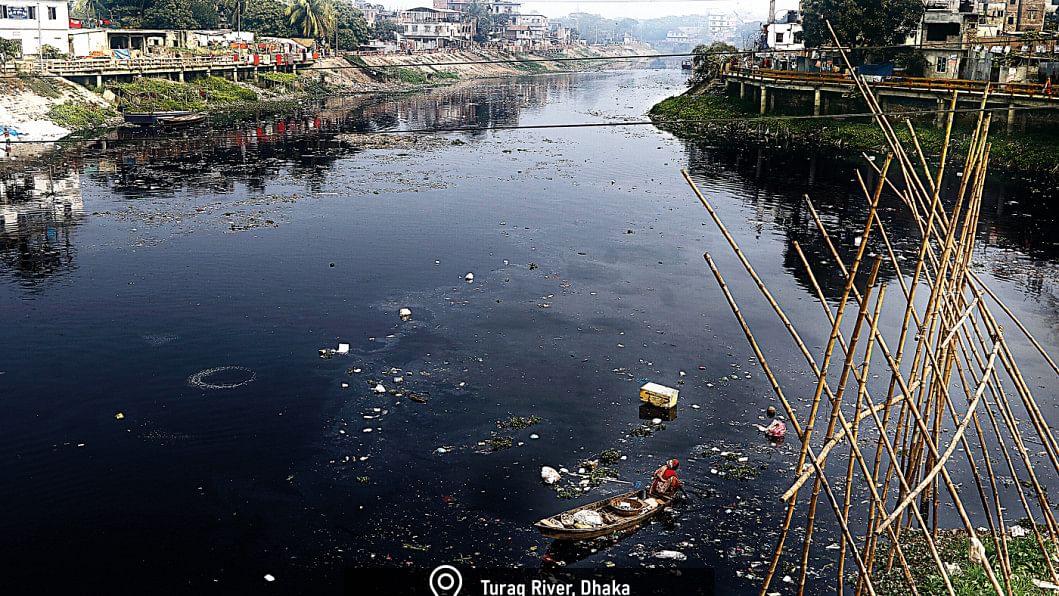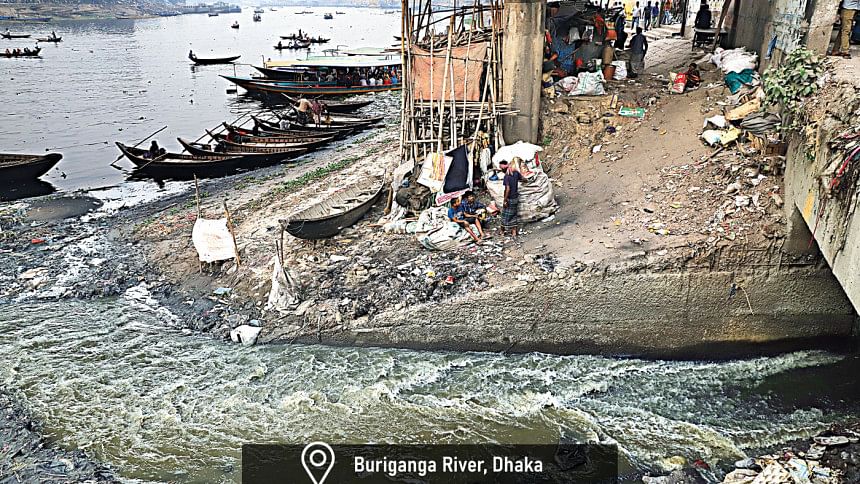Dhaka rivers under onslaught

The rotten stench emanating from the polluted Buriganga water hits the nostrils even before reaching the river’s bank.
There, a grey bearded man is spotted under the Shaheed Buddhijibi bridge.
He introduces himself as Shafiqul Islam Khokan. His five-storey house, painted red, is situated on the East bank of the Buriganga river, hardly 10 feet away from the waterbody.
How is the quality of the water, he is asked.
“It is the same as before. No change.”
Shafiqul, 65, said he was born and raised entirely in Basila area near the Buriganga.
He still remembers the time when the water of river sparkled, in testament to its purity. But then the rampant dumping of liquid waste in the river since the 80s changed the colour of the river in front of his very eyes.
When asked if the government’s move to relocate tannery industries from Hazaribagh to Savar had helped, he repeats that all is “the same as before.”
“Every year, things improve for two to three months during the monsoon. Otherwise, the colour of the water is black and it is stinky. The water quality deteriorates further in February and March if there is no rain,” he adds.

NOTHING HAS CHANGED
The fishermen’s neighbourhood in Basila is just 200 metres away from Shafiqul’s house.
This is where one Surjaban Rajbanghsi lives.
Surjaban said 150 fishermen families used to live in two villages along the Buriganga just 30 years ago.
But as the fish were driven from the river, most of the fishermen left the area too.
Lakkhi Rajbangshi, a local, said they have to tolerate the foul smell of the river all year round as they live right beside it.
“Also we face tremendous problems as we were entirely dependent on river water. We collect drinking water from our neighbours’ house now and we can no longer bathe in the river or wash our clothes there,” she said.
The situation is no different for Ayesha Akhter, who lives in the Rupali housing area on the bank of the Shitalakhya area under Bandar thana of Narayanganj, some 30 kilometres off Basila.
“We often need to cross the river by boat to go to Narayanganj city and we cannot do that without putting handkerchiefs over our noses,” she said.
Elsewhere, people from Gazipur, especially those living in the Tongi area, bear witness to the destruction the polluted Turag river has wreaked.
“We used to grow paddy and other crops in the agricultural land. But we cannot grow anything here due to pollution in the Turag. Nearly one lakh acres of agricultural land remain uncultivated due to industrial pollution,” said Masudul Hasan Billal, former commissioner of Haidrabad Musundirbagh area.
Visiting the rivers around Dhaka city recently, this correspondent found that none of the four rivers -- Buriganga, Turag, Shitalakhya and Balu -- showed any sign of improvement.
Murky, foul-smelling and pitch black water is a common feature of all the rivers.
The downstream rivers like the Meghna and Shitalkhya are also under onslaught from the effluents pouring in from the Buriganga, Turag and Balu rivers.
It is as if nothing has changed in the last decade, despite the High Court repeatedly asking the government to take necessary actions since 2001.
In a verdict on July 15, 2001, Justice ABM Khairul Haque said, “The sorry state of affairs cannot continue unabated.” He observed that the current picture was not a matter of legislation, but it became so due to the unresponsiveness of the government officials concerned.
MUCH ADO, FEW RESULTS
The Department of Environment (DoE) began preparing reports on water quality of the main rivers of the country after the HC directed it to do so in 2010.
Starting from then, the department has prepared reports till 2017 and is currently working on the 2018 report.
The water quality reports make for grim reading.
All available reports show the level of dissolved oxygen in the waters of Buriganga, Shitalakhya, Turag and Balu to be almost zero, especially during the dry season, from January to May.
The minimum level of dissolved oxygen in water must be at least five mg per litre in order for fish and other aquatic lives to survive.
The government shifted tanneries from Hazaribagh to Savar in 2016 in a measure to improve water quality.
Not only did that not work, but the relocation of the tannery estate near the Dhaleshwari river has polluted what was once a clean river. The ineffective central effluent treatment plan is to blame for that.
Against this backdrop, the government sprang into action. The DoE conducted drives against polluting industries and made them install effluent treatment plants (ETPs).
Interestingly, by 2018 most of the polluters installed ETPs, DoE data shows.
In the department’s 2018-19 annual report, it showed that of 2,087 polluting factories in and around Dhaka, 1,691 had set up ETPs, while 104 others were in the process to do so.
This, however, may not be enough.
Dr Mohidus Samad Khan, a teacher at the chemical engineering department of Bangladesh University of Engineering and Technology, who has been working on checking industrial pollution, said “Even if all the polluting industries operate ETPs and discharge the liquid into the river after treating it as per the law, still it will pollute the river. Because, the standard as per the rules of our Bangladesh Environment Conservation Act is not up to the mark,” he said.
He said while the average Biological Oxygen demand (BOD) is around 5mg per litre, as per the Bangladesh Environment Conservations Rules (1997), industries are allowed to discharge waste water up to 50 mg per litre.
Samad said as per their research, garments industries will discharge 20, 300 crore litres of waste water into the rivers flowing around Dhaka by 2021.
Tannery and other industries are not included here, he said.
Asked, AKM Rafique Ahammed, director general (DG) of the DoE, said they were acting in accordance with the HC order which directed them to improve the water quality of the river.
“But it takes time. All other countries in the world that polluted waterbodies, cleaned it after a lot of effort. Also, it took a lot of time.”
Environmentalists differ in this regard.
“I think the prime minister really wanted to stop pollution and recover rivers from encroachment after the HC directive. But the problem was in execution. We all know government officials have a nexus with polluters and encroachers. That’s why the quality of river water has not improved yet,” said Syeda Rizwana Hasan, chief executive, Bangladesh Environment Lawyers Association (Bela).
She said the government spent taxpayers’ money and relocated the tannery industries from Hazaribagh to Savar.
“But they could not fix the central effluent treatment plant in the last two years. So a whole new river is being polluted,” said Rizwana who filed several public interest litigations over the years which resulted in the HC directives on saving rivers.
As for the central ETP, which can handle 25,000 cubic feet of water daily, problems may arise as it is not equipped to process salt. In turn, it releases salt water into the rivers and salt is a common substance used by tanneries.
In 2009 the HC declared all four rivers flowing around the Dhaka city as ecologically critical area.
Since then, the court delivered around 100 different directions to the government to free the country’s rivers from encroachers and pollution.
On February 3, 2019 the HC declared rivers as a “legal entity,” having rights similar to a living person. The High Court appointed the National River Conservation Commission (NRCC) as the guardian of rivers and assigned it the responsibility of upholding the rights granted to rivers.
Regarding continuation of river pollution, Muzibur Rahman Howlader, chairman of the NRCC, raised an important issue.
He said Bangladesh has made progress in many things but could not develop a modern waste management system. Whatever waste management the country had in Dhaka and a few other places was very conventional. But in most areas, there is no waste management system at all and all the waste just ends up in the rivers.
“The government has to work on this issue if we want to stop river pollution,” he said.
MEGHNA NOW IN TROUBLE TOO
As the government could not stop river pollution in Gazipur, Dhaka and Narayanganj, the downstream Meghna river is being polluted from those sources, a recent study by the Asian Development Bank (ADB) said.
The level of chromium has exceeded drinking water standards at a number of locations in the Bishnandi canal, just upstream of a drinking water intake point, and should be treated as a potential risk, the report states.
Currently, the Dhaka Water Supply and Sewerage Authority (DWASA) has taken two projects of bringing water from Meghna to supply to Dhaka residents. If the pollution is not checked, it will severely hamper Wasa’s plan of providing over 40 percent of drinking water for the capital’s 20 million residents.
The report mainly blames the industrial waste for this pollution.
Sharif Jamil, secretary general of Bangladesh Poribesh Andolon (Bapa), also Bangladesh representative of International Riverkeeper, said, the ongoing pollution of rivers was due to the government not properly using the laws.
“None of the government officials who allowed industrialists to pollute rivers was punished. The government also did not take any initiative to do zoning of pollutant garment industries. So basically the pollution shifted from one place to another, but it did not stop,” said Sharif Jamil.

 For all latest news, follow The Daily Star's Google News channel.
For all latest news, follow The Daily Star's Google News channel. 



Comments